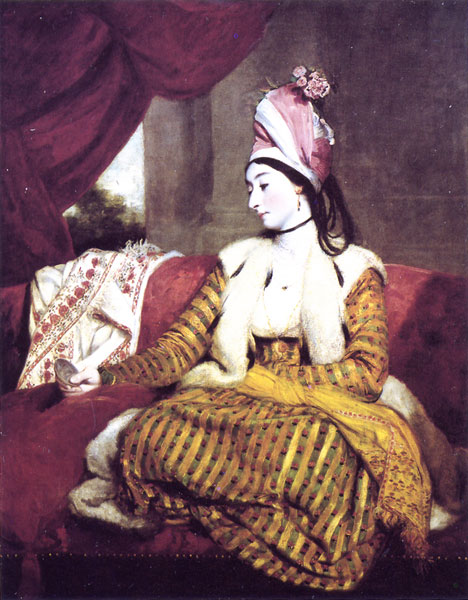 |
Sir Joshua Reynolds painted a striking portrait of Mrs Baldwin, wearing the oriental fancy dress she wore to a royal ball in 1782, and kept the picture all his life. He volunteered to paint her - probably with a view to the impression the glamorous portrait would make on prospective clients. The picture had not been seen since 1945, and was assumed lost for ever, but has just resurfaced in a private American collection. It sold at Christie’s for over £3m. in London November 2003 (the second highest auction price ever realised for a work by the artist). Mrs Baldwin was born Jane Maltass, the daughter of an English merchant, in Smyrna in 1763. She married George Baldwin, who became the British consul in Alexandria. Widely travelled, she attracted admiration and gossip wherever she went. After the painter’s death in 1792 her portrait was bought by the Swedish painter Carl Fredrik von Breda. After passing through the hands of R Hall McCormick, whose family owned the Chicago Tribune, and William Randolph Hearst, it was sold in New York in 1945, and then disappeared. Some experts thought it might have been destroyed - further information:
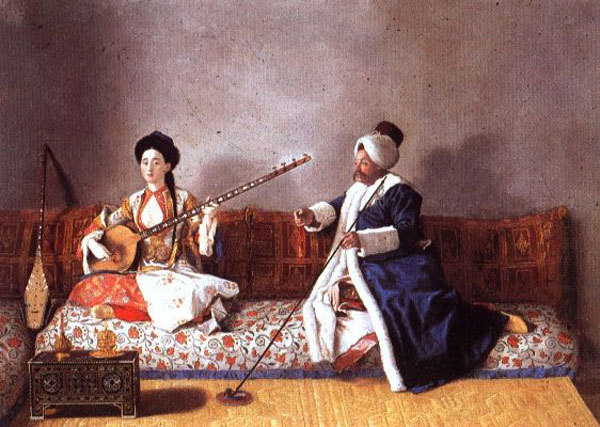 |
The famous painting of ‘Monsieur Levett and Mademoiselle Helene Glavany in Turkish Costumes’ by Jean-Etienne Liotard that has recently been bought by the Louvre. Helene Glavany was the daughter of Saverio Glavani (Consul of France in Ottoman Crimea) & Marguerite Fabre, painted sometime 1738-42 during the painter’s Turkey residency -
Francis Levett was the partner of Andrew Turnbull, (1718–1792) who was a British Consul at Smyrna. Turnbull organized the largest attempt at British colonization in the New World by founding New Smyrna, Florida, named in honor of his wife’s birthplace. New Smyrna, Florida Colony, founded in 1768, encompassed some 101,400 acres (410 km2) and was nearly three times the size of the colony at Jamestown.
Turnbull married Maria Gracia Dura Bin, the daughter of a Greek merchant from Smyrna, Asia Minor, secured a grant of 40,000 acres (160 km2) of land in conjunction with Sir William Duncan, for the East Coast of Florida, with the requirement from the British government that it be settled within 10 years in the proportion of one person for every 100 acres (400,000 m2). Turnbull sailed for America in 1765 and in St. Augustine, Florida, he secured the grant of land from Governor James Grant. The land grant was located about 75 miles (121 km) south of St. Augustine, in what is now New Smyrna Beach, Florida. He then returned to England where he secured financing for his forthcoming venture through bounties from the government and the Board of Trade, and then sailed for the Mediterranean to search for his colonists “for a Tract of Land in East Florida on which I might settle a small Colony of Greeks,” as Turnbull explained in a letter to Lord Shelburne.
One of Turnbull’s prospective partners in the venture was Francis Levett, an English factor working in Livorno for the Levant Company. From a powerful English mercantile family with extensive trading connections, Levett hoped to use his pull in the Levant to supply Greek laborers to Turnbull’s new colony.[1] Later Levett left London, where he had relocated, and settled in British East Florida, where he was granted a 10,000-acre (40 km2) plantation by Governor Grant. His collaboration with Turnbull apparently came to naught.[2]
In June, 1767, Turnbull arrived with his ships in the Mediterranean, and he visited Minorca; Leghorn, Italy; Smyrna, Asia Minor; the island of Melos; Mani, Koroni, Greece; Methoni, Greece; Crete; Santorini; Corsica; Mahon. He found opposition from French, Italian, and Turkish authorities, who did not want to see their subjects leave, but after persistent efforts, he finally rounded up about 1,400 colonists and left for his new colony in East Florida, which he was to name “New Smyrna” in honor of his wife, a native of Smyrna, Asia Minor.
References:
^ Proceedings of the Massachusetts Historical Society, Vol. III, Published by the Society, Boston, 1859
^ Julianton Plantation, Florida History Online, unf.edu.floridahistoryonline
^ Levett references in the British archives
information courtesy of Marie Anne Marandet.
Turnbull married Maria Gracia Dura Bin, the daughter of a Greek merchant from Smyrna, Asia Minor, secured a grant of 40,000 acres (160 km2) of land in conjunction with Sir William Duncan, for the East Coast of Florida, with the requirement from the British government that it be settled within 10 years in the proportion of one person for every 100 acres (400,000 m2). Turnbull sailed for America in 1765 and in St. Augustine, Florida, he secured the grant of land from Governor James Grant. The land grant was located about 75 miles (121 km) south of St. Augustine, in what is now New Smyrna Beach, Florida. He then returned to England where he secured financing for his forthcoming venture through bounties from the government and the Board of Trade, and then sailed for the Mediterranean to search for his colonists “for a Tract of Land in East Florida on which I might settle a small Colony of Greeks,” as Turnbull explained in a letter to Lord Shelburne.
One of Turnbull’s prospective partners in the venture was Francis Levett, an English factor working in Livorno for the Levant Company. From a powerful English mercantile family with extensive trading connections, Levett hoped to use his pull in the Levant to supply Greek laborers to Turnbull’s new colony.[1] Later Levett left London, where he had relocated, and settled in British East Florida, where he was granted a 10,000-acre (40 km2) plantation by Governor Grant. His collaboration with Turnbull apparently came to naught.[2]
In June, 1767, Turnbull arrived with his ships in the Mediterranean, and he visited Minorca; Leghorn, Italy; Smyrna, Asia Minor; the island of Melos; Mani, Koroni, Greece; Methoni, Greece; Crete; Santorini; Corsica; Mahon. He found opposition from French, Italian, and Turkish authorities, who did not want to see their subjects leave, but after persistent efforts, he finally rounded up about 1,400 colonists and left for his new colony in East Florida, which he was to name “New Smyrna” in honor of his wife, a native of Smyrna, Asia Minor.
References:
^ Proceedings of the Massachusetts Historical Society, Vol. III, Published by the Society, Boston, 1859
^ Julianton Plantation, Florida History Online, unf.edu.floridahistoryonline
^ Levett references in the British archives
information courtesy of Marie Anne Marandet.
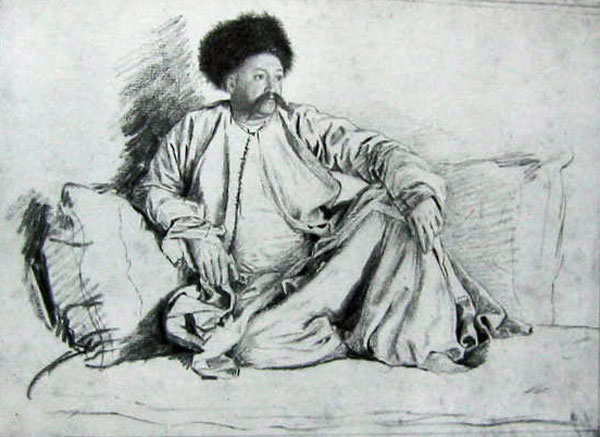 |
‘Mr Levett in Tatar costume’ (1738-1740) featured again, in a sketch by Jean-Etienne Liotard. Mr Levett an English merchant in Constantinople was sketched at least twice more by this artist. Mr Francis Levett (? - c. 1764) was a representative of the Levant Company in Constantinople at least from 1737 to 1750.
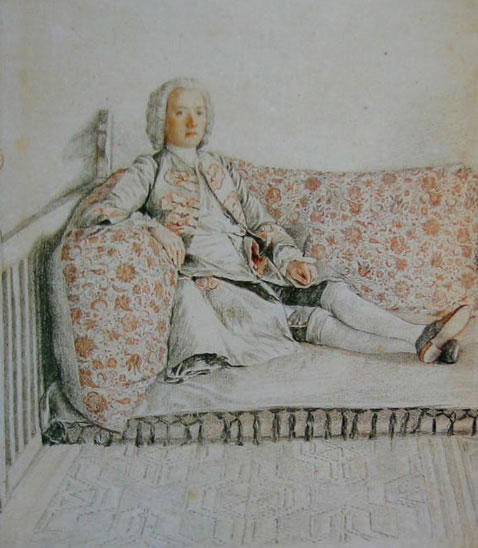 |
Another portrait by Jean-Etienne Liotard: The French consul of Smyrna, Gaspard de Péleran (died October 1747)
- Consul in Aleppo (1722-1730) - Consul in Smyrna (1731-1747) (info: archives de la Chambre de Commerce de Marseille).
Burried in the the grounds of the Catholic church of Saint Polycarpe in Smyrna - Headstone epitath:
Burried in the the grounds of the Catholic church of Saint Polycarpe in Smyrna - Headstone epitath:
“D.O.M.
HIC JACET DOMINUS GASPAR DE PELERAN
IN TURCICO IMPERIO CONSUL GALLUS
VIR A LAUDATIS VIRIS SAEPE LAUDATUS
REGIIS ADMINISTRIS APPRIME CARUS
NEC MEDIOCRI HONORE AB IPSO REGI INSIGNITUS
BARBARAE GENTI TOTA YS IUSTORUM
IPSI....PRAE CAETERIS FORMIDOLOSUS
CONSILIO DE VERITATE INGENII COMPLUENTIUM
LINGUARUM PERITUS DE OMNIBUS PERINDE
AC DE SUIS...ITUS... DE SUA...
INGENS...SUI...DESID.....RELIQUIT AN..QUIVIT
..ACENA...MINOR QUI SMYRNIS INEUNTE OCTOBRI
ANNO SALUTIS HUMANAE MDCCXLVII”
HIC JACET DOMINUS GASPAR DE PELERAN
IN TURCICO IMPERIO CONSUL GALLUS
VIR A LAUDATIS VIRIS SAEPE LAUDATUS
REGIIS ADMINISTRIS APPRIME CARUS
NEC MEDIOCRI HONORE AB IPSO REGI INSIGNITUS
BARBARAE GENTI TOTA YS IUSTORUM
IPSI....PRAE CAETERIS FORMIDOLOSUS
CONSILIO DE VERITATE INGENII COMPLUENTIUM
LINGUARUM PERITUS DE OMNIBUS PERINDE
AC DE SUIS...ITUS... DE SUA...
INGENS...SUI...DESID.....RELIQUIT AN..QUIVIT
..ACENA...MINOR QUI SMYRNIS INEUNTE OCTOBRI
ANNO SALUTIS HUMANAE MDCCXLVII”
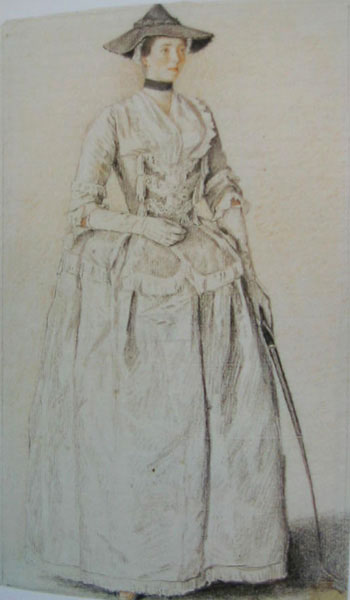 |
Again painted by Liotard - wife Consul de Péleran: Marie Boyer, daughter of Véran Boyer, French merchant (died Nov. 13th, 1786 in Smyrna). After de Péleran’s death she remarried Ridélius the Swedish Consul in Smyrna.
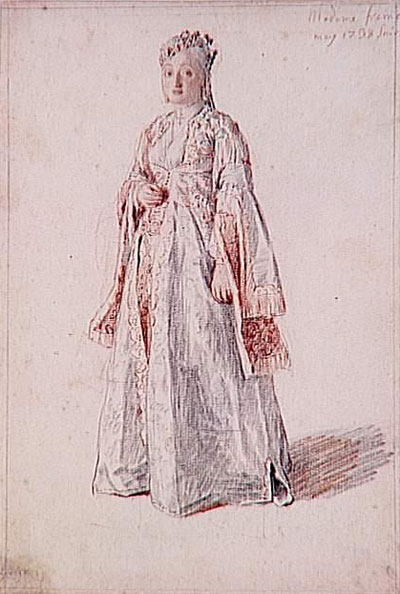 |
Portrait of Mrs James Fremeaux, née Margaret Cooke, Smyrna by Jean-Etienne Liotard (1702-1789)
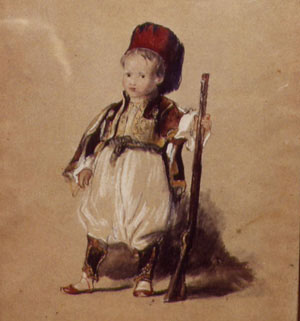 |
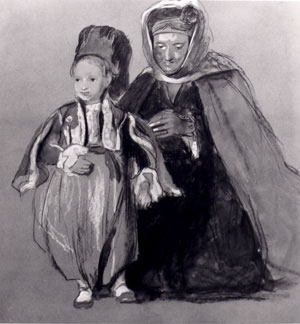 |
Sir James Whittall as a boy depicted in oriental fashion, a portrait executed
by Sir David Wilkie shortly before he died on board ship on his return to
England. The roll-over shows the copy the artist kept for himself, that
surfaced in an auction in London in the 1970s.
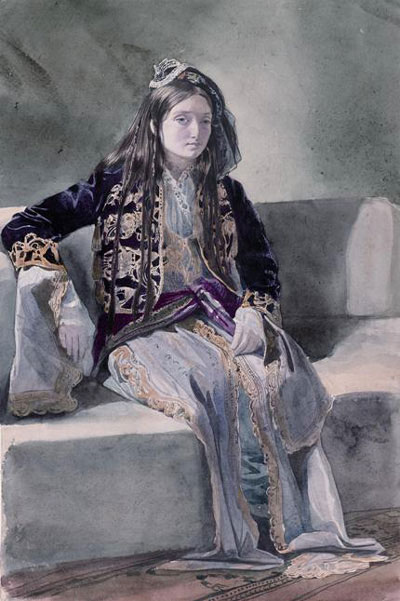 |
Charles Gleyre (1806-1874) Femme Turque (‘Madame Langdon’), Smyrna, 1834. Mrs Langdon was Louise Christine nee Gout who married the American merchant Joseph Langdon in 1830. Joseph Langdon was from Boston in America, a trader and an unofficial American consul of Smyrna. He met Louisa Gout when she was only 15 and married soon after wards in 1830 (8 Oct) when he was 31. Louisa Gout was the daughter of the British James Louis Gout (born in London 11 March 1777) and the mother was of Dutch nationality, Christine Fercken. This family were described as typical Smyrna ‘Franks’ suggesting a long settled existence. More on the Langdon ancestry here: Both Mr and Mrs Langdon (died 1856) are buried in the Boudjah cemetery near Smyrna, and they had children whose descendants are still alive today.
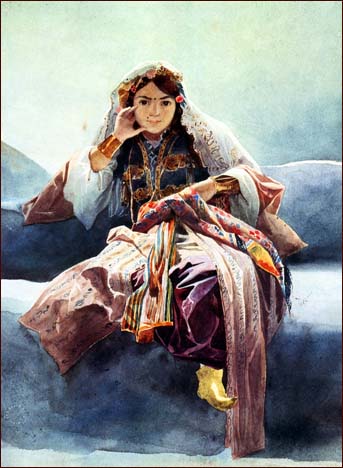 |
‘Angelica’ by Charles Gleyre, Swiss. Watercolor, 1834. She was the eleven year old daughter of his Levantine host in Constantinople and her name was Angelica Calaphanti.